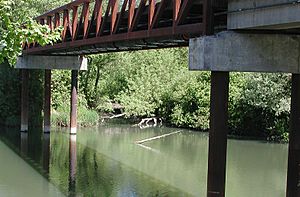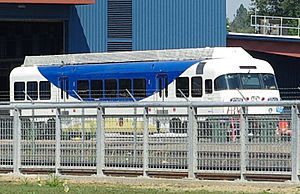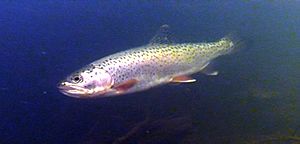Fanno Creek facts for kids
Quick facts for kids Fanno Creek |
|
|---|---|

Fanno Creek in Greenway Park, Beaverton
|
|
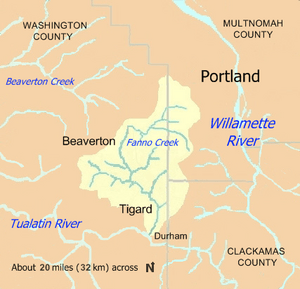
Fanno Creek watershed
|
|
|
Location of the mouth of Fanno Creek in Oregon
|
|
| Country | United States |
| State | Oregon |
| County | Multnomah and Washington |
| Physical characteristics | |
| Main source | Tualatin Mountains (West Hills) Portland, Multnomah County, Oregon 478 ft (146 m) 45°28′44″N 122°42′00″W / 45.47889°N 122.70000°W |
| River mouth | Tualatin River Durham, Washington County, Oregon 108 ft (33 m) 45°23′35″N 122°45′50″W / 45.39306°N 122.76389°W |
| Length | 15 mi (24 km) |
| Basin features | |
| Basin size | 31.7 sq mi (82 km2) |
Fanno Creek is a 15-mile (24 km) long stream in Oregon, USA. It flows into the Tualatin River. The creek is part of the larger Columbia River system. Its watershed, or the area of land that drains into it, covers about 32 square miles (83 km²) across three counties: Multnomah, Washington, and Clackamas. About 7 square miles (18 km²) of this area is within the city of Portland.
The creek starts in the Tualatin Mountains (also called the West Hills) in southwest Portland. It then flows west and south through cities like Portland, Beaverton, Tigard, and Durham. It also passes through undeveloped areas of Washington County. Fanno Creek joins the Tualatin River about 9 miles (14 km) upstream from where the Tualatin River meets the Willamette River near West Linn.
Long ago, the Kalapuya people lived in this area. They had moved here after the Multnomahs. In 1847, the first European settler, Augustus Fanno, started an onion farm in what is now Beaverton. The creek was named after him. His old family home, the Augustus Fanno Farmhouse, is now a historic site. It is one of 16 parks located along the creek.
Even though the creek has faced pollution, it still supports aquatic life. This includes coastal cutthroat trout in its upper parts. Groups like the Fans of Fanno Creek and government agencies are working hard to reduce pollution. They also help restore native plants along the creek's banks.
Contents
Where Does Fanno Creek Flow?
Fanno Creek starts at an elevation of 478 feet (146 m) above sea level. By the time it reaches its mouth, it has dropped 370 feet (110 m) to an elevation of 108 feet (33 m). The main part of the creek begins in the Hillsdale neighborhood of southwest Portland.
The creek flows west, following the north side of Oregon Route 10. It passes through Albert Kelly Park. Other small streams like Ivey Creek and Bridlemile Creek join it. Soon after, it enters Washington County and the area of Raleigh Hills. Here, it flows under Route 10 and Sylvan Creek joins it.
The stream then turns south, going through Bauman Park. Vermont Creek joins it here. It continues southwest through the Portland Golf Club and Vista Brook Park, where Woods Creek enters. From there, it flows west again for about 1 mile (1.6 km). It passes through Fanno Creek Trail Park and enters Beaverton. Then it turns sharply south and flows under Oregon Route 217.
Fanno Creek then runs next to Route 217 for about 2 miles (3.2 km). It goes through Fanno Creek Park and Greenway Park. Near the end of Greenway Park, the creek passes under Oregon Route 210 and enters Tigard. Several other creeks, like Hiteon Creek, Ash Creek, and Summer Creek, join it. The creek then flows through Woodard Park, under Oregon Route 99W, and through Fanno Park and Bonita Park. Red Rock Creek and Ball Creek also join it. Finally, Fanno Creek enters Durham, flows through Durham City Park, and empties into the Tualatin River.
How Much Water Flows in Fanno Creek?
The U.S. Geological Survey (USGS) measures the water flow in Fanno Creek at two places. One is in Durham, close to the mouth of the creek. The other is in Portland, further upstream.
At the Durham station, the creek's average flow is about 43.9 cubic feet per second (1.24 m³/s). This measurement covers almost all of the Fanno Creek watershed. The highest flow ever recorded there was 1,670 cubic feet per second (47 m³/s) in December 2007. The lowest flow was 1 cubic foot per second (0.028 m³/s) in September 2001 and 2009.
At the Portland station, the average flow is much smaller, about 3.15 cubic feet per second (0.089 m³/s). This station measures only about 7 percent of the total watershed.
What is the Fanno Creek Watershed Like?
The Fanno Creek watershed covers 31.7 square miles (82 km²). It collects water from the Tualatin Mountains (West Hills) in Portland, Sexton Mountain in Beaverton, and Bull Mountain near Tigard. Most of this area is urban, meaning it has many buildings and roads. About 7 square miles (18 km²) of the watershed is inside Portland.
The highest point in the watershed is 1,060 feet (320 m) at Council Crest in the West Hills. Sexton Mountain is 476 feet (145 m) high, and Bull Mountain is 715 feet (218 m) high. There are about 117 miles (188 km) of streams flowing through the watershed, including Ash Creek, Summer Creek, and 12 smaller streams. A small part of the watershed is in Lake Oswego, near the start of Ball Creek, which flows into Fanno Creek.
The soil in the watershed is mostly silt and clay. This means erosion is common. About 50 inches (1,300 mm) of rain falls on the watershed each year. Most of this rain comes in November, December, and January. While there was a big flood in 1977, the area has not had a major flood since it became urban.
How Healthy is the Water?
Since 2015, Portland's Bureau of Environmental Services (BES) has given "report cards" for the parts of watersheds within the city. They grade water health in four areas:
- Hydrology: How much pavement and other hard surfaces are in the watershed, and how freely streams flow.
- Water Quality: Measures of dissolved oxygen, bacteria, temperature, and chemicals like mercury.
- Habitat: The condition of stream banks, floodplains, and riparian zones (areas along the water).
- Fish and Wildlife: Looking at birds, fish, and small water creatures.
In 2015, the Fanno Creek watershed received these grades in Portland:
- Hydrology: C
- Water Quality: C+
- Habitat: B−
- Fish and Wildlife: D−
History of Fanno Creek
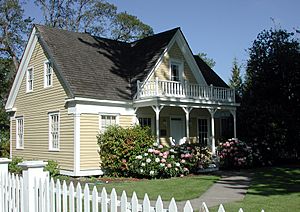
Before European settlers arrived, the Atfalati (or Tualaty) tribe of the Kalapuya people lived in the Fanno Creek area. They had moved there before Europeans came. The valleys of the Willamette River and its branches, like the Tualatin River, were open grasslands. The Kalapuya kept these areas open by burning them each year. They also had scattered groups of trees along rivers and creeks.
The Kalapuya moved around in good weather to fish, hunt small animals, birds, deer, and elk. They also gathered nuts, seeds, roots, and berries. Important foods included camas and wapato. They fished for eels, suckers, and trout. They also traded for salmon with other tribes near Willamette Falls. In winter, the Kalapuya lived in longhouses in settled villages.
Their population greatly decreased after they met Europeans in the late 1700s. Europeans brought diseases like malaria, smallpox, and measles. White settlers also took and fenced off native land, which they saw as private property. This caused more problems for the native people. In 1780, there were about 1,000 to 2,000 Atfalati. By 1851, only 65 remained. In 1855, the U.S. government moved the survivors to the Grande Ronde reservation.
Fanno Creek is named after Augustus Fanno, who was the first European American settler along the creek. In 1847, he started an onion farm on a 640-acre (260 ha) land claim. This area later became part of Beaverton. Other settlers in the 1800s mostly did logging, farming, and dairy farming.
Around the early 1900s, the Southern Pacific Railroad and the Oregon Electric Railway lines made the area easier to reach. This led to more urban development. The Oregon Electric Railway ran between Portland and Garden Home in the Fanno Creek watershed. The Southern Pacific also ran electric passenger trains called the Red Electric in the area. By 1915, the population of the upper Fanno Creek neighborhoods had grown to 2,000 people.
Passenger train service on the Red Electric line stopped in 1929, and the Oregon Electric Railway stopped passenger service in 1933. Cars largely replaced these trains. Today, Oregon Highway 217 and Oregon Highway 10 follow the creek. Even though passenger trains stopped for nearly 80 years, freight trains continued to use the tracks.
In 2009, a new passenger train service called the Westside Express Service (WES) started. It uses a former Oregon Electric line in Washington County. WES runs 14.7 miles (23.7 km) between Beaverton and Wilsonville. Part of this route is close to the lower 8 miles (13 km) of Fanno Creek. WES was the first modern commuter train in Oregon. It connects to the MAX Blue Line and MAX Red Line light rail systems, which link to Portland International Airport.
The population in the Fanno Creek area grew a lot in the second half of the 1900s. When Beaverton became a city in 1893, it had 400 people. By 2010, it had grown to 94,000. Tigard became a city in 1961 and grew to 49,000 people by 2013. Fanno Creek, which had few people living near it until 1850, is now surrounded by the most populated area in Oregon.
What About Pollution in Fanno Creek?
The Oregon Department of Environmental Quality (DEQ) said that Fanno Creek's water quality was "very poor" between 1986 and 1995. However, they also noted that it was steadily improving. In the past, Fanno Creek was polluted by city and factory waste, old sewage treatment plants, bad septic systems, farms, and illegal dumping.
Concerns about health and the environment led to the closing of poor wastewater treatment plants in the 1970s. As cities grew, there were fewer farms and farm animals along the creek. A ban on phosphate detergents in 1991, more connections to city sewers, better stormwater management, and public awareness helped reduce pollution. This led to improved water quality.
DEQ monitors Fanno Creek in Tigard. On their water quality index, scores range from 10 (worst) to 100 (ideal). Fanno Creek's average score was 55 between 1986 and 1995. By the end of that period, it had improved to 65, which is considered "poor." For comparison, the nearby Willamette River had an average score of 74 during the same years.
Measurements showed high levels of phosphates, bacteria, and suspended solids in Fanno Creek. There was also a high demand for oxygen in the water. During heavy rains in fall, winter, and spring, there were also higher levels of ammonia and nitrate nitrogen. High temperatures and low oxygen in the summer showed signs of eutrophication, which means too many nutrients in the water.
It is hard to improve water quality because a large part of the watershed is covered by hard surfaces like roads and buildings. These surfaces do not let water soak into the ground. Instead, water runs off quickly, carrying pollutants into the creek. To help with this, groups are planting native plants in the watershed. These plants help slow down runoff, reduce erosion, and keep pollutants out of the streams.
Animals and Plants of Fanno Creek
Fish and Wildlife in the Creek
About 100 different kinds of birds, several types of mammals, and a few fish species live in the Fanno Creek watershed. Common mammals include beavers, raccoons, opossums, spotted skunks, Douglas squirrels, and Townsend's chipmunks. Black-tail deer and coyotes are seen less often.
Fanno Creek is home to coastal cutthroat trout that do not migrate. They spawn (lay eggs) in the fast-flowing, gravelly parts of the creek's headwaters. These trout can grow up to 14 inches (36 cm) long. Other fish found in the creek include sculpins, mosquitofish, and eels.
Beavers, which can weigh up to 60 pounds (27 kg), have sometimes caused issues along Fanno Creek. In 2014 and 2015, more beavers started chewing down trees and building dams in Greenway Park in Beaverton. The rising water from these beaver dams has sometimes covered trails in the park. Park officials are looking at ways to deal with this, like moving trails or building boardwalks.
Vegetation Along the Creek
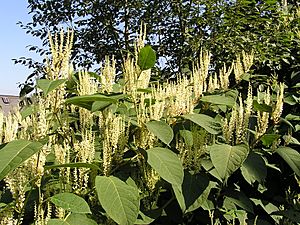
The creek starts in the Coast Range area and then flows through the Willamette Valley area. The narrow strips of land along the streams often have native plants like western redcedar, Douglas fir, vine maple, and sword fern. However, there are also invasive plants like English ivy. Many red alder and big leaf maple trees grow here. Shrubs include red huckleberry, Oregon-grape, elderberry, wood rose, and salmonberry.
A project in Tigard has removed invasive plants like reed canary grass and Himalayan blackberry. They have replaced them with native plants. Another project in Beaverton is replacing grass and damaged areas with native shrubs and trees, such as Oregon white oak.
Groups like the Tualatin Riverkeepers, Clean Water Services, and the Tualatin Hills Park & Recreation District (THPRD) are working together. They form the Tualatin Basin Invasive Species Working Group. Their goal is to find and remove invasive plants that harm native plants, cause erosion, and make water quality worse. The five most harmful plants they focus on are Japanese knotweed, meadow knapweed, giant hogweed, garlic mustard, and purple loosestrife.
Parks Along Fanno Creek
Fanno Creek flows through or near 16 parks managed by different groups. Portland Parks & Recreation manages three parks:
- Hillsdale Park: 5 acres (2.0 ha) with picnic tables and a dog park near the creek's start.
- Albert Kelly Park: 12 acres (4.9 ha) with paths, picnic tables, play areas, and Wi-Fi.
- Fanno Creek Natural Area: 7 acres (2.8 ha) with natural spaces.
The Tualatin Hills Park & Recreation District (THPRD) manages seven Fanno Creek parks in Beaverton and Washington County. This is the largest park district in Oregon. These parks include:
- Bauman Park: About 8 acres (3.2 ha).
- Vista Brook Park: About 4 acres (1.6 ha) with trails, a playground, and sports courts.
- Fanno Creek Trail: About 2 acres (0.81 ha) with picnic tables and trails.
- Fanno Creek Park: About 21 acres (8.5 ha) with accessible trails.
- Fanno Farmhouse: About 1 acre (0.40 ha) with an accessible trail, picnic tables, and the historic Fanno family home.
- Greenway Park: About 87 acres (35 ha) with trails, picnic tables, a playground, and sports fields.
- Koll Center Wetlands: About 13 acres (5.3 ha) with wildlife.
The city of Tigard manages five Fanno Creek parks:
- Englewood Park: 15 acres (6.1 ha) with play structures and trails.
- Woodard Park: 15 acres (6.1 ha) with large trees, trails, and play structures.
- Bonita Park: 3.5 acres (1.4 ha) with a playground and picnic areas.
- Dirksen Nature Park: 48 acres (19 ha) of forest, wetlands, and open space.
- Fanno Creek Park: A 30-acre (12 ha) natural area in downtown Tigard.
The small city of Durham has a lot of parkland. Durham City Park, where Fanno Creek meets the Tualatin River, is 46 acres (19 ha). It has many trees, paved trails, play areas for children, and a picnic shelter.
Sections of trail along Fanno Creek are part of a planned 15-mile (24 km) Fanno Creek Greenway Trail. This trail will connect Willamette Park in Portland to where the creek meets the Tualatin River in Durham. The trail is for people walking and biking, and it is designed to be accessible for people with disabilities. Some parts of the trail were still being finished as of 2013.
Images for kids



